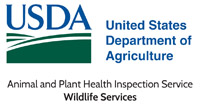United States Department of Agriculture: Animal and Plant Health Inspection Service

United States Department of Agriculture Wildlife Services: Staff Publications
Document Type
Article
Date of this Version
2014
Citation
Applied Animal Behaviour Science 154 (2014) 83–92.
Abstract
Surgical sterilization of coyotes (Canis latrans) reduced their predation rate on domesticsheep. We investigated whether sterilizing coyotes would similarly change coyote pre-dation rates on pronghorn antelope (Antilocapra americana) neonates. From May 2006 toMarch 2008, we radio-collared 71 pronghorn fawns to determine survival rates in south-east Colorado, USA. During the first year of the study, all coyotes were reproductively intact. During the second year, we surgically sterilized 15 coyotes from 10 packs in the southernhalf of the study area, while nine coyotes from seven packs in the northern half were givensham sterilizations (i.e., remained reproductively intact). In addition, we estimated theavailability of alternative prey and coyote density on both areas to evaluate predator–preyfactors that could interact with the sterilization treatment. Using the known fate model in Program Mark, we constructed models with and without a treatment effect, plus year, area,individual covariates, alternative prey indices, and predator density to estimate pronghornfawn survival rates. Results from model averaged parameter estimates and cumulative summer survival indicated coyote sterilization increased survival rates of pronghorn fawns byreducing predation rates of fawns. While fawn survival was higher overall in the northarea, after treatment was applied, cumulative pronghorn fawn survival during the summerof 2007 in the south area was 242% higher for pronghorn fawns captured in sterile coyoteterritories (0.44; 79-day interval survival rate) compared to fawns captured in intact coyoteterritories (0.18). There was also a significant local area effect, but no relationship betweenfawn survival and individual fawn covariates of sex, birth weight, birth date, or age. Norelationship was detected between fawn survival and lagomorph abundance index, rodentabundance index, or coyote density. Surgical sterilization of coyotes was useful in reducingpredation rates on pronghorn fawns.


Comments
U.S. government work.